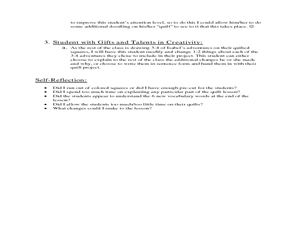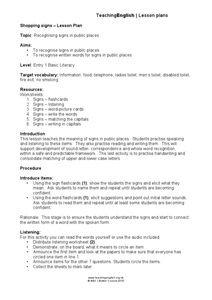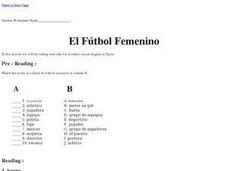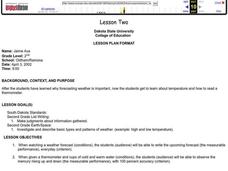Curated OER
Symmetry in Children's Art Experiences
Read between the lines of symmetry to make important connections between math, art, culture, and nature.
American Library Association
Even and Odd Numbers: Lesson Plans and Sample Problems
If your youngsters are new to numbers, here are several interactive strategies to get them thinking about even and odd numbers. For example, they can count the number of desks, people, etc. in the room and determine if it is even or odd....
Curated OER
Children Using Antonyms to Write Short Stories
Second graders discuss what antonyms are and read the book, Quick as a Cricket. In this antonym lesson, 2nd graders write a short story by describing themselves.
Curated OER
Love It or Leave It?
Students identify flags by country, then research the symbolism and history of those flags in preparation for writing and delivering oral presentations. For homework, they write essays reflecting on the relationship between flags,...
Curated OER
Review: Basic Spanish Phrases
Wow, what a review packet! Through several exercises, beginning Spanish language learners will review Spanish phrases, questions, and responses. Common expressions, numbers, and weather are all touched on here. If your class just...
Macmillan Education
Get Thinking
Have a go at this exercise in thinking by asking thinkers to think about thinking, of what they think of, and what they think about. The worksheets in the packet provide much food for thought.
Curated OER
Elements of Poetry
Prepare your learners to identify figurative language in poetry. Tips for reading poetry and what to look for are listed on these slides. Rhetorical devices are defined and plenty of examples are given.
Novelinks
The Joy Luck Club: Vocabulary Strategy (Magic Squares)
As part of their study of Amy Tan's The Joy Luck Club, readers engage in a magic squares vocabulary activity.
EngageNY
Percent
Extend percent understandings to include percents less than one and greater than 100. A great lesson has pupils build upon their knowledge of percents from sixth grade. They convert between fractions, decimals, and percents that are less...
Curated OER
Learning the Roles in Literature Circles
I love literature circles! Get your pupils together and have them discuss the book they are reading. They determine and practice their role in the literature circle then discuss the book they are reading. This is a great introduction to...
American Museum of Natural History
Trip Up Your Brain
Sometimes different parts of the brain disagree. See what this disagreement looks like using a remote learning resource to experience how brains often take shortcuts. Pupils complete the activity, observe their results, and then read...
Curated OER
Finding James Fort
Welcome to Jamestown! Third and fourth graders read and analyze primary source documents about Jamestown or Fort James. They read and analyze descriptions of Fort James from primary sources. They access a website to explore more...
Curated OER
Understanding Irony
Students discuss irony. In this language arts lesson, students identify irony and give examples of irony from their lives, a book, and current events. Students classify types of irony.
Curated OER
Patchwork Adventure Poetry
Third graders explore poetry by completing a worksheet. In this poetry instructional activity, 3rd graders create a quilt using images students have drawn based on imagery. Students practice using vocabulary from the poem "Adventures...
Curated OER
Recognizing Signs in Public Places
Students explore symbols by identifying public signage. In this public safety lesson, students view flashcards of everyday road, fire and food signs while discussing their function and purpose. Students record and identify road and...
Curated OER
Who, What, Where, When, and Why
Pupils explain the concepts of market system, command and mixed economy. They describe the differences between needs and wants. They compare and contrast different government and economic systems.
Curated OER
London Slang Exercise
In this London slang worksheet, students translate London slang and translate regular phrases into slang. Students complete 13 problems in all.
Curated OER
Children's Literature Across the Curriculum Ideas-Ira Sleeps Over
Students read Ira Sleeps Over by Bernard Waber. They complete a variety of cross-curricular activities surrounding the ideas presented in the story. Included are reading, art, math, science, writing, social studies, and library...
Curated OER
Kwanzaa: An African-American Heritage Celebration
Students explain some of the symbols of Kwanzaa. They demonstrate their understanding of Kwanzaa by making a book about what they have learned.
Curated OER
Salinity
Learners define and discuss salinity, conduct classroom experiment to determine salinity of water sample by using hydrometer, record predictions, and demonstrate understanding of how salinity influences object's ability to float in water.
Tech Coach Corner
Understanding Sentences
Go over how to read complex sentences. Learners work on identifying key ideas, examining sentence structure, looking up new vocabulary, and paraphrasing. An overview of methods to help class members read difficult texts, half of the...
Curated OER
El Fútbol Femenino en España
Students use a worksheet to help focus their research on Spain's national women's soccer league. They access primary sources in Spanish and write a journalistic article using their findings.
Curated OER
Lesson Two
Second graders, after assessing why forecasting weather is important, study about temperature and how to read a thermometer. They experiment being able to observe the mercury rising up and down when given a thermometer and cups of cold...
Curated OER
Telling Time as an Everyday Use of Numbers
How can we estimate time? Have your young mathematicians make a clock. Then they compare and contrast types of clocks. They practice writing times in two different ways and make a book about telling time.

























